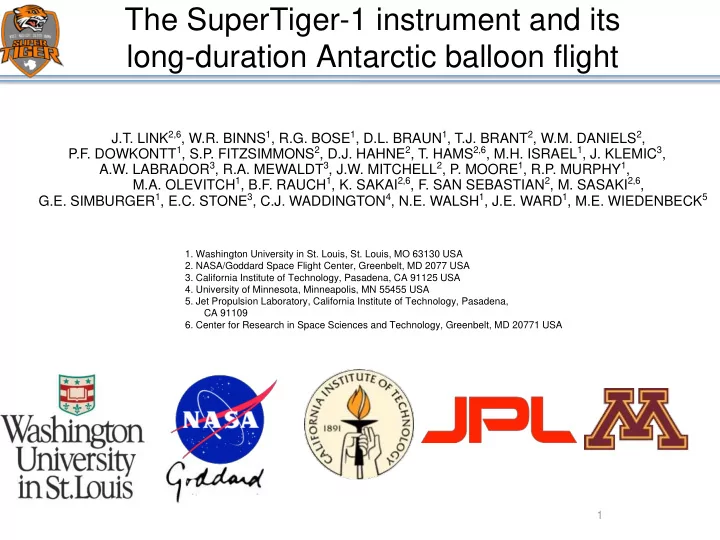

The SuperTiger-1 instrument and its long-duration Antarctic balloon flight J.T. LINK 2,6 , W.R. BINNS 1 , R.G. BOSE 1 , D.L. BRAUN 1 , T.J. BRANT 2 , W.M. DANIELS 2 , P.F. DOWKONTT 1 , S.P. FITZSIMMONS 2 , D.J. HAHNE 2 , T. HAMS 2,6 , M.H. ISRAEL 1 , J. KLEMIC 3 , A.W. LABRADOR 3 , R.A. MEWALDT 3 , J.W. MITCHELL 2 , P. MOORE 1 , R.P. MURPHY 1 , M.A. OLEVITCH 1 , B.F. RAUCH 1 , K. SAKAI 2,6 , F. SAN SEBASTIAN 2 , M. SASAKI 2,6 , G.E. SIMBURGER 1 , E.C. STONE 3 , C.J. WADDINGTON 4 , N.E. WALSH 1 , J.E. WARD 1 , M.E. WIEDENBECK 5 1. Washington University in St. Louis, St. Louis, MO 63130 USA 2. NASA/Goddard Space Flight Center, Greenbelt, MD 2077 USA 3. California Institute of Technology, Pasadena, CA 91125 USA 4. University of Minnesota, Minneapolis, MN 55455 USA 5. Jet Propulsion Laboratory, California Institute of Technology, Pasadena, CA 91109 6. Center for Research in Space Sciences and Technology, Greenbelt, MD 20771 USA 1
What can Ultra-Heavy GCRs Tell Us • How are GCRs accelerated? • What are the source materials for the GCR nuclei? Henize 70 Superbubble in the LMC (FORS/VLT Telescopes, ESO ) • Ultra-Heavy nuclei (those with a Z >30) are produced by the s- and r-processes in stars and supernova explosions. These nuclei are then accelerated to cosmic-ray energies most likely by supernova explosions in OB associations. • Recent work suggests that an additional source of ultra-heavy nuclei may be needed for particles above ~Z=54. Binary neutron star mergers are one possibility. 2 • These particles are excellent probes of the material source and acceleration process of cosmic-rays. Nebula surrounding Wolf Rayet Star WR124 in Saggetarius constellation. (Hubble Wide Field Planetary Camera 2)
Elemental Abundances in the Galactic Cosmic Radiation ♦ Elements in the upper 2/3rds of the periodic table, are extremely rare compared to lighter elements. ♦ Measurement requires large instruments at the top of the atmosphere for long exposure times .
SuperTIGER Instrument Scintillator 1 Hodo_top Aerogel Cherenkov Acrylic Cherenkov Scintillator 2 Hodo_bottom Scintillator 3 • Stack of 7 detectors – 3 Scintillation counters – 2 Scintillating Fiber Hodoscopes – 2 Cherenkov Detectors • Aerogel, n =1.043 or 1.025 (2.5 or 3.3 GeV/nucleon) • Acrylic, n = 1.49 (0.3 GeV/nucleon) • Two nearly identical modules • Effective area 2.9 m 2 sr, 7.2 times that of TIGER. • See instrument paper: Binns et al. ApJ (2014) 788:18 4
Super-TIGER Detectors
SuperTIGER-1 Instrument 6
SuperTIGER-1 Balloon Flight and Recovery • December 8, 2012-February 1, 2013 • 55 day flight--(NASA Heavy-Lift Scientific Balloon Record!) Collected 4.7 x 10 6 iron events • • Detectors and electronics completely recovered in 2014-2015 season. Team of 4 camped for 31 days at landing site. 7
Data Analysis Technique Low Energies: Scintillator vs Acrylic C High Energies: Acrylic C vs Aerogel C Energy> 800 MeV/nuc at top of atmosphere
Data Analysis Technique Low Energies: Scintillator vs Acrylic C High Energies: Acrylic C vs Aerogel C High Energy Branch Low Energy Branch Energy> 800 MeV/nuc at top of atmosphere
Resolution for Z ≤ 30 Low Energy High Energy (below C0) (above C0) Si Fe Ca S Ni Co Cu Zn Combined
HEAO 3 Heavy Nuclei Experiment Data 30 < Z < 62 Source: Binns et. al. Astrophysical Journal , 346 , 1989
Charge histogram for 30 ≤ Z ≤ 40 nuclei Abundances of 30 ≤ Z ≤ 40. We get well -defined charge peaks for every element from Z= 30 to 40 (Bin size 0.125 cu). 12
SuperTIGER-II Improvements • SuperTIGER selected for a second flight in 2017-2018 Antarctic season. • Instrument currently in Palestine Texas for final integration • Improvements over SuperTIGER-1 – Additional storage and disk drive redundancy – Will use open port iridium in addition to TDRSS telemetry which will give us complete high-priority data coverage for entire flight – Improved scintillator PMT/WLSB mounting scheme to address damage to PMTs most likely caused when we wintered over on the ice. – Redesigned HV power supplies and testing procedures to address the issues we saw with a small number of supplies in ST-1 Flight
Summary • The first flight of SuperTIGER in 2012-2013 was highly successful –55 day flight duration (44 days equivalent data due to telemetry outages) –Paper on elemental abundances published (ApJ 831:148, 2016) • SuperTIGER-II flying December, 2017 • Future flights of SuperTIGER a possibility as are space missions on ISS (TIGERISS) or free flying sattelites (HNX).
SuperTIGER Related Presentations at this conference • CRD105 (Alan Labrador) Galactic Cosmic Ray Energy Spectra for Ne through Cu from 0.8 to 10 GeV/nuc with the SuperTIGER instrument • CRD047 (Nathan Walsh) Preliminary SuperTIGER Abundances of Galactic Cosmic Rays for the Charge Interval Z=41-56 and Prospects For SuperTIGER-II • CRD138 (John Krizmanic) Ultra-Heavy GCR Measurements Beyond SuperTIGER: HNX and TIGERISS
Recommend
More recommend